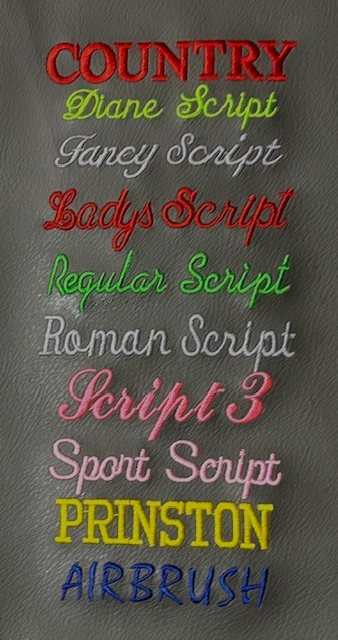The Art of Personalized Needlework: Opening the Keys to Creating One-of-a-kind and Memorable Layouts
Needlework, a craft soaked in practice and virtuosity, holds within its detailed stitches the power to change textile right into a canvas of special expression. The tricks to producing customized embroidery designs that astound the eye and leave a long-term impact hinge on a delicate balance of technique, creativity, and attention to information. As we explore the world of custom needlework, we reveal the nuanced interplay between string option, stitch complexity, and layout customization that raises a mere garment to a job of art. Join us on a trip with the art of custom needlework as we unwind the secrets behind crafting really memorable and distinct developments.
Selecting the Right Embroidery Threads
When selecting needlework strings, what key variables should you consider to make sure the very best results for your custom-made layouts? The selection of needlework string is crucial in identifying the final result of your stitched layout. Among the key considerations is the material of the thread. Different materials such as cotton, polyester, rayon, and silk provide varying levels of shine, durability, and texture. It is vital to choose a thread material that matches the material you are embroidering on and lines up with the preferred appearance of the style.
Furthermore, the weight or density of the string plays a substantial function in the appearance of the embroidery. Thicker strings can include dimension and texture to your design, while finer strings are suitable for detailed information and tiny text. In addition, thinking about the color fastness and washability of the string is crucial to ensure that your personalized designs maintain their top quality and vibrancy over time. By carefully evaluating these factors and choosing top quality threads that satisfy your specific needs, you can boost the aesthetic allure and longevity of your stitched creations.
Checking Out Various Stitch Techniques
To look into the realm of 'Discovering Different Stitch Methods', one must comprehend the intricacies and nuances that each sewing method gives the art of needlework. Different stitch methods not just include visual rate of interest yet also contribute to the general appearance and dimension of the style. One preferred stitch strategy is the satin stitch, which involves carefully stuffed parallel stitches to create a smooth and shiny surface, perfect for filling out shapes and producing vibrant outlines.
On the other hand, the backstitch is a flexible method usually used for detailing and including great information. It entails sewing backward to create a solid line of embroidery. Furthermore, the French knot stitch includes a responsive component to layouts, excellent for developing distinctive accents like flower facilities or decorative touches.
Exploring different stitch techniques allows embroiderers to play with light, shadow, and depth within their styles, raising the visual charm and creative high quality of their needlework jobs. By grasping different sewing techniques, one can unlock limitless possibilities for producing distinct and unforgettable customized embroidery pieces.
Incorporating Personalized Design Elements
Having checked out the complexities of different stitch methods such as the satin stitch, backstitch, and French knot, the focus currently changes in the direction of including personalized layout components in personalized needlework jobs. Customized style aspects play a critical duty in making embroidery tasks genuinely one-of-a-kind and unforgettable. One means to integrate personalization is by adding initials, names, or significant days to the style. This not only includes a tailored touch yet likewise improves the sentimental worth of the needlework piece.
An additional method to include customized layout elements is by including icons or motifs that hold special definition to the recipient or reflect their rate of interests and individuality. Including a favorite flower, animal, or hobby-related icon can make the needlework design a lot more purposeful and personalized. Additionally, selecting shades that reverberate with the recipient or straighten with the intended theme can additionally boost the personalization of the embroidery job.
Grasping the Art of Shade Control
One trick aspect of color control is understanding color concept. This consists of shirts made to order understanding just how different shades connect with each other, the emotions they share, and how they can be combined to develop visually appealing styles. By using color theory concepts, embroiderers can develop harmonious color combinations that boost the general look of the layout.
In addition, focusing on contrast is important in color sychronisation. Using contrasting shades can aid particular elements of the design pop, improve legibility, and create an aesthetically dynamic embroidery item. By understanding the art of color control, embroiderers can raise their layouts and develop unforgettable pieces that resonate with customers and audiences alike.
Enhancing Appearance With Advanced Needlework Stitches

Bullion knots, on the tailor made t shirts various other hand, can be utilized to develop twisted, ropelike elements that include a luxurious feeling to the embroidery. Experimenting with these innovative needlework stitches allows you to press the borders of traditional embroidery and develop truly special and visually enticing appearances in your styles.
Conclusion
In final thought, the art of customized embroidery includes a combination of selecting the best threads, discovering various stitch methods, incorporating customized layout aspects, grasping shade sychronisation, and boosting structure with innovative stitches. By comprehending and implementing these crucial elements, embroiderers can develop distinct and remarkable designs that display their creativity why not find out more and skill. Needlework enthusiasts can open the keys to producing beautiful and bespoke items that stick out and leave an enduring perception.